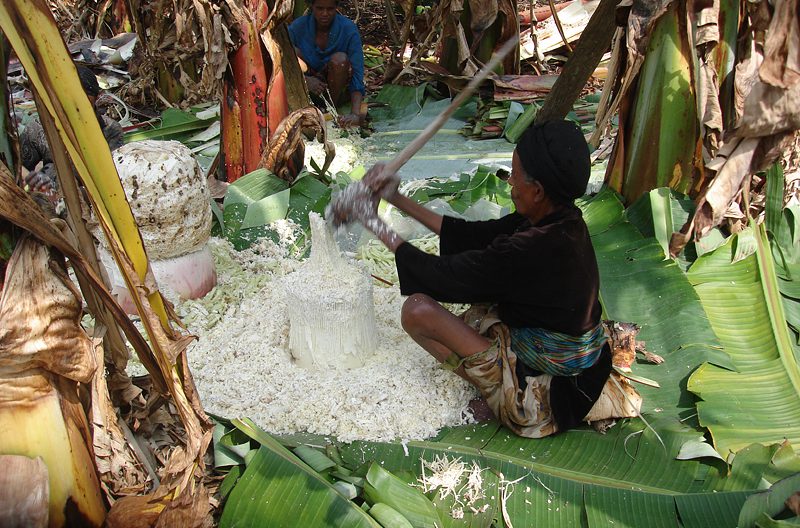
BY ALAZAR SHIFERAW
In a recent interview with The Ethiopian Herald, Addis Ababa University (AAU) Department of Pharmaceutics and Social Pharmacy lecturer, Tesfaye Gabriel said that currently, he and his collogues have been engaging in starch and cellulous research and production. They are working on producing different industry inputs from starch and cellulous. The researchers mainly plan to produce starch from diosecorea, cassava and enset.” These plants are mostly cultivated in the southern parts of Ethiopia.
He further said; “We can extract starch from ‘bula’ part of enset and got a promising result.” The ‘bula’ which is prepared from enset has over 90 percent starch content. But, these three plants have different properties.
Moreover, he said that as they differ by their physicochemical properties, they also differ in their benefits too. They highly use for medicine factories. For example, starch is being used as a glue; used for stamping, and a binder in medicine factories. Moreover, starch by nature is hydrophilic, it absorbs water and disintegrates. Besides, through chemical modification, through chemical modification methods, starch can be used as a gelling agent and used to make other derivatives too. It is possible to improve its fluidity as well. Besides, starch used to shape tablets but sometimes it can be disintegrated in the mouth, he said.
However, native starch has many limitations. As a result, it has to be modified through chemical process. So far, “we have mainly focused on chemical and physical modification duties.”
He further said that cellulous stands first among global polysaccharides and according to some literatures starch can take the second place. Locally, it can be produced from plant resources and microorganisms. Cellulous can be extracted from enset, teff straw, and sugar factory byproducts.
But unless they are modified, the native products will be low. In the present science and technology, cellulous can be used for many purposes, to make airplanes wings, used for plastic factories, paper, garment factories, beverage, food industries, in pharmaceutical industry.
He further said that celluloses are extracted from teff straw, enset fiber, sugarcane bagasse and coffee hull and agro-industrial byproducts generated in large quantities in Ethiopia. The present study aims to explore these plant byproducts as alternative sources of cellulose for potential industrial applications, using various eco-friendly chlorine-free treatment conditions to obtain an optimum cellulose extraction condition.
The byproducts and the extracted celluloses were analyzed for chemical compositions, yield, chemical functionality, crystallinity, thermal stability and morphology. The byproducts and the as-extracted celluloses showed cellulose crystal lattice, various studies revealed enhanced stability of the as-extracted celluloses. On the basis of the physicochemical characteristics of the celluloses, all the byproducts studied could be considered as alternative sources of cellulose for potential value-added industrial applications.
International of food science in its “Characterization, Functional Properties, and Resistant Starch of Freshwater Macrophytes by Farahin Syid and Muta among others said that starch plays a vital role in food and nonfood industries, such as in pharmaceutical, paper, textiles, biomedical, and polymer, because of its gelling characteristics, thickening, water binder, and food system stabilizing capacities.
Research on the structure and physicochemical properties of starch in cultivated plants, maize, cassava and potato resulted in their extensive utilization in food industries. However, other plants besides those mentioned above may possess potential and promising alternative starch sources, it said.
Asian countries such as China and Japan had cultivated aquatic macrophytes such as lotus, Chinese water chestnut, water caltrop, taro and arrowhead for starch-based food. The research conducted showed that starches from macrophytes could also be a promising candidate as an energy source in the food-related industry. Water chestnut corm flour helps as a thickening agent and dusting powder in food preparation.
Arrowhead corms, and water caltrop fruits are eaten boiled or cooked and can be dried and ground into a powder. Taro tuber possesses low fat, high carbohydrate, and minerals content and suitable as a food ingredient for baby food, chips, and bread.
Lotus seeds, consumed boiled or processed into powder, are also used in the pharmaceutical industry to treat inflammation, arrhyth mia, cancer, and skin diseases. Most of the starch’s diverse uses are from cultivated species and research on the wild species is still scarce, it said.
Research on starch isolated from freshwater macrophytes such as cattails, arrowhead, yellow nutsedge, and duckweed and their physicochemical properties are also available and less prevalent. Although consumed by local communities, their local utilization was seldom reported in the literature. Nowadays, consumers are engaging with resistant starch to promote health benefits similar to high-amylose starch. It is poorly digested starches and absorbed in healthy individuals’ small intestine due to its complex molecular structure.
Investigating the aquatic macrophytes starches, among others, is to create awareness of their various uses and economic values. Besides Starch is one of the most important value-added food ingredients used as a thickener in many foods and industrial applications, it said.
The Ethiopian Herald July 9/2021





